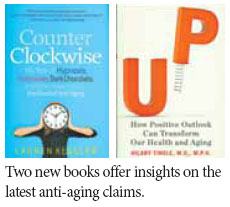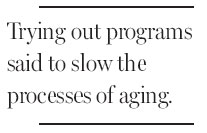Pursuing longevity, with body and mind
Updated: 2013-07-21 08:25
By Abigail Zuger, M.D.(The New York Times)
|
|||||||||

A huge number of how-to books have been written to cater to the industry that has sprung up around the notions of how to think and feel young.
As Lauren Kessler estimates in "Counterclockwise," at the rate of a book a week it would take almost 160 years to read them all. That didn't stop her from writing one more, of course.
Ms. Kessler, who never mentions her age, tested popular techniques. "I did everything," she says, "so you don't have to."
She starts with the cosmetics of aging, visiting researchers at the University of North Carolina who specialize in digitally aging faces. Their work provides a detailed scientific analysis of the wreckage time leaves behind: The face alone sustains almost two dozen assaults, from sunken cheeks to larger ears (the cartilage actually grows).
Ms. Kessler investigates plastic surgery options. Everything she hears is light on the blood and gore, heavy on the appealing metaphors. Young skin is spandex; older is linen and needs loving attention. "I am seduced by this language," she admits.
She undergoes a little botulinum toxin treatment to the forehead ("the change is subtle, like good lighting") and a variety of potions and laser treatments. Surgery on the rest of the body she leaves to those with "more money than sense."

Then it is on to the body's interior. Ms. Kessler's first step is a complete evaluation of her risks for imminent collapse, with measurements of blood pressure, cholesterol, stamina, flexibility, oxygen-using ability. She even has a researcher check the health of her mitochondria, cell components whose vigor wanes with age. It turns out she has the mitochondria of a fit young woman, "way too much" body fat, fabulous blood pressure and borderline cholesterol.
Time to embark on the cure. Ms. Kessler starves, diets, detoxes, cleanses, and eats berries, salmon and all the good-fat-filled, antioxidant-rich edibles of current vogue. She stretches, lifts weights, runs races, and signs up for classes featuring the repeated spurts of all-out exertion thought to optimize fitness.
She lies on a hypnotist's couch to cultivate calm and optimism. It is this forward-looking spirit which, she suspects, kept her great-great-grandmother preparing the family breakfast well into her 10th decade.
After a year Ms. Kessler has improved enough in some objective measures of biologic age to support current estimates that a full 70 percent of the disability of age may be caused by factors within our control. (The other 30 percent is genetic, and even the most energetic test subjects can't do a thing about it.)
For those who want more information about the mind and aging, Dr. Hilary Tindle's "Up" may help.
Dr. Tindle has unusually strong credentials in this field. A cardiologist at the University of Pittsburgh, she is among those whose research shows that optimists live longer, healthier lives than pessimists.
As an expert in the new science of outlook, Dr. Tindle offers definitions of optimism and pessimism, supplies a questionnaire for readers to rate their tendencies, and provides "seven steps of attitudinal change" for those who come up short. These steps will probably be especially useful for individuals with a particularly bad quality known as "cynical hostility," which she has found to be associated with a 16 percent elevation in mortality over eight years.
Some people are, sadly, too far gone to view this statistic with anything but cynicism and hostility, but those who can still save themselves may be well advised to do so.
The New York Times
(China Daily 07/21/2013 page11)